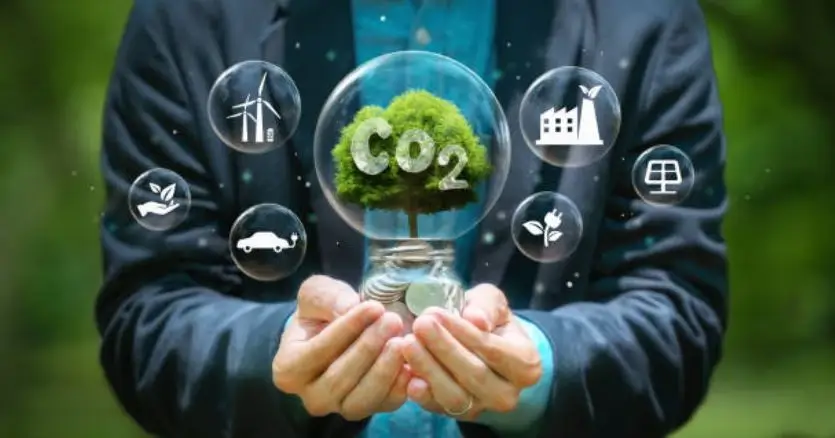Introduction to Renewable Energy and Environmental Impact: Renewable energy is one of the solutions to problems within the global environment. Those like solar, wind, and hydro powers which do not affect nature in the provision of electricity.
In contrast with the sources of non-renewable energy which results in emission of toxic gases into the atmosphere, renewable sources of energy do emit any gases at all. This shift assists in mitigation of climate change to a certain extent, reduction in air pollution and conservation of natural resources/evironments.
How Renewable Energy Helps to Decrease Carbon Emissions?
The Role of Solar Energy in Lowering Carbon Footprint:
Using solar energy is one of the solutions that members of society can take to reduce the emission of carbon. That means that while generating electricity through solar energy, no fuel is combusted, making it a source of clean energy.
Traditional power plants utilize coal, which discharges carbon dioxide, a greenhouse gas, thus causing the greenhouse effect. Solar panels allow people in homes and businesses to produce their own electricity, thus ending the use of fossil fuels.
Useful for the production of wind power as a clean energy solution:
There is also wind power, which is also deemed a sustainable source of power and which also assists in reducing emissions of carbon. Wind turbines make use of the movement of air in order to generate electrical power. While coal and gas emissions have some amount of carbon dioxide, wind energy is, therefore, environmentally friendly.
Many countries are now coming up with large wind farms that will act as the source of energy instead of installing fossil fuel power stations. The energy from the wind is also cheap or affordable since one of the sources of wind is unlimited.
Hydropower and Its Contribution to a Greener Future:
Hydropower or water-generated electricity is an important prospect in establishing efficient energy for the future. The power source is derived from water that is in a constant flow to turn turbines that generate electricity, and not by the combustion of fuel.
This has made the generation of electricity using this method reduce carbon emissions than coal and gas plants. Hydropower also gives reliable energy as the flow of water is constant and relatively more predictable as compared to the wind.
Renewable Energy and Air Quality Improvement

Sustainable energy is known to be one of the leading strategies through which air pollution:
Particularly, the combustion of fossil fuels has various negative impacts on the environment, leading to air pollution. The coal and gas electric power facilities emit various negative substances such as sulfur dioxide and nitrogen oxides. which contribute to the formation of smog and respiratory diseases. These pollutants are not emitted by renewable energy, such as solar and wind energy.
Cities become healthy when the air quality improves, and this is achieved when a country switches to clean energy sources. Huge amounts of investments have gone into renewable energy developments. As they aim at solving air pollution, which is a threat to the people of urban areas.
The Health Benefits of a Cleaner Atmosphere:
A cleaner air would therefore benefit the health of all people, as they will not be at the risk of getting diseases from the polluted air that is circulating in their surrounding environment. This problem has its dramatic consequences, such as causing asthma, lung diseases, and heart conditions. When fossil fuels are combusted, they release particles into the environment and cause pretty severe health problems.
It will mean smaller amounts of these negative emissions; thus, a lower incidence of respiratory diseases and less health expenses. Existing research highlights that regions that utilize a lot of renewable energy have fewer instances of air pollution-borne diseases. Therefore, there is ample need for using green energy as it enables the community to live healthier lives, as well as improving the surrounding air.
Water Conservation Benefits of Renewable Energy

How Solar and Wind Energy Reduce Water Consumption:
Tremendous quantities of water are used in fossil fuel power plants for cooling and processing purposes. This increases the pressure on water supply from freshwater sources, especially in arid areas of the world. On the other hand, solar and wind energy are sources of electricity that do not use water as an indispensable element.
This makes them suitable for use in water conservation programs. By relying more on these sources of energy, one can make effective use of natural resources in the future by using less water.
Hydraulic Power in Perspective of the Sustainability of Water Resources:
Hydropower also offers an opportunity to generate electricity from a renewable resource, as well as assisting in water resource management. A lot of hydropower dams contain water as a deposit that can be useful for irrigation and drinking. Though the conventional hydropower plant has some issues associated with it environmentally, modern technology is making them more effective. The countries have now developed an ecologically friendly hydro power system throughout the world. Which does not harm or affect the aquatic life, and also provides better water management.
Economic and Social Advantages of Green Energy Adoption
Job Creation in the Renewable Energy Sector:
Renewable power can also be considered a major source of employment as it is a huge industry across the globe. Each year, there is development in the erection of solar panels and jobs in wind turbines, and operations in hydro plants. Whereas the employment sector of fossil fuel is diminishing, renewable energy provides long and sustained job opportunities.
Currently, governments and companies are investing in green technology that offers millions of job opportunities to people all over the world. Concretely, the use of stakes indicates that economies can be developed and at the same time, the natural environment can be protected through adopting renewable energy sources.
Energy Independence and Long-Term Sustainability:
The countries dependent on fossil fuel imports face an economic and political problem. It offers an assurance to the independent generation of power, thus cutting down on the imports of oil and gas. These two achievements guarantee energy independence, hence improving national security, and prevent fluctuating electricity prices.
Also, renewable energy sources cannot be exhausted, making it possible to have a steady and continuing source of energy. Renewable energy will be manufactured, making the contracts to secure green energy easier and risk-free in terms of the economy.
Challenges and Future Prospects of Renewable Energy

Overcoming Storage and Infrastructure Limitations:
This paper reviews the foremost challenges within the renewable energy area, and one of the primary of them is referred to as energy storage. From the aforementioned definitions of the two energy sources, we clearly understand that they are both dependent on weather, and this may sometimes be unreliable. To overcome this difficulty, researchers are working on more effective methods of storing battery energy for use in the future when necessary.
It’s also important to reinforce the power grid to be able to accommodate renewable energy. Over the years, there have been many improvements in the technology used in harnessing renewable energy, and these challenges will be addressed, making energy more reliable.
Government Policies and Global Renewable Energy Goals:
Here, the governments happen to also have the major responsibility of promoting renewable energy. Some of the facts include contracts, tax exemptions or incentives, subsidies, regulatory measures, and credits to promote green energy adoption. Many countries today have planned for the increase and are making use of energy to fight climate change.
The global goals that require the reduction of carbon emissions through the use of renewable sources of energy are the global climate change agreements, like the Paris Agreement. This is so because countries today have put policies in place, and there is a high increase in cooperation in the development of renewable energy.
Conclusion:
Renewable energy is very important when it comes to the survival of a healthy planet in the future. Thus, it lowers carbon emissions, enhances the quality of the air and water, and preserves ecosystems.
The advantages of green energy are quite clear and good for the economy and for creating jobs, and make a good source of energy for future needs. Nevertheless, some obstacles persist as technology and governments keep pushing towards the onset of a cleaner world.
FAQs:
Q1: What is the significance of renewable energy for the environment?
A1: Renewables decrease pollution /carbon footprint and preserve the environment and the natural population.
Q2 Employing wind power in energy generation has several benefits to the community?
A2: Wind power electrical energy is produced without involving the use of fossil fuels, which causes the emission of greenhouse gases.
Q 3: What are the economic implications of utilizing renewable energy sources?
A3: It leads to job creation, economic benefits of the locals, and it curtails expenditures on energy.
Q4: What is the largest difficulty with renewable energy?
A4: Energy storage and infrastructure upgrades are important, but the new technologies have been developed to deal with them.
Q5: In what way is renewable energy important to people’s health?
A5: It decreases air pollution and consequently the number of respiratory diseases that affect human beings and the environment.



